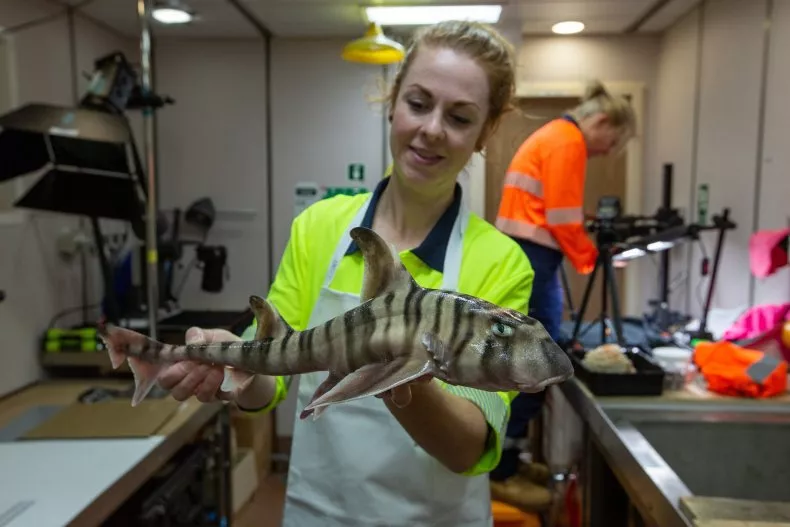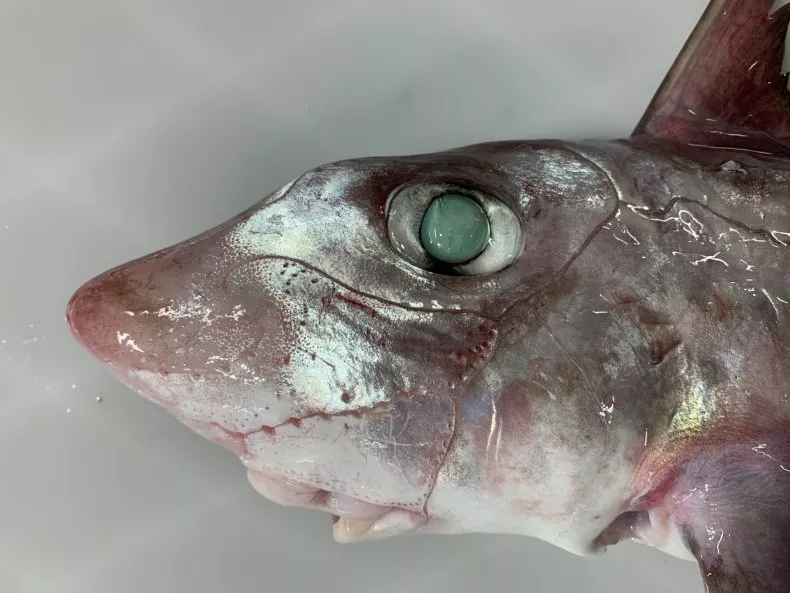A new type of shark has been found off the coast of Western Australia. The discovery was made by researchers from Australia's national science agency during a biodiversity survey at the Gascoyne Marine Park. The shark, which was described as small and stripey, was collected early in the voyage. Will White, a shark expert from the agency's Australian National Fish Collection, made the announcement.
Horn sharks are a group of shark species identified for their spiny fins as well as their pronounced ridges further their eyes. It is believed that horn sharks are usually seen in the shallow waters of the eastern and western Pacific and the western region of the Indian Ocean. However, a new species of horn shark has recently been discovered in the deep waters off the coast of Australia. So far, scientists know little about its behavior or characteristics, as it has yet to be formally described and named.
Researchers at the Commonwealth Scientific and Industrial Research Organization (CSIRO), an Australian science agency, have a model specimen of the new species that they will use to study and describe it. The discovery of this new species was made as part of a broader research effort to better understand the diversity of marine life in some of the deepest and most remote waters in Australia, as stated in the agency's press release.

Adding to the Shark-list
The Commonwealth Scientific and Industrial Research Organization (CSIRO), recently discovered during a research voyage to the Gascoyne Marine Park off the coast of Western Australia. The team found a new species of horn shark, which has yet to be formally described and named. This discovery follows another recent voyage by CSIRO to the Cocos (Keeling) Islands Marine Park, where the team discovered an underwater "graveyard" containing hundreds of shark teeth, including those of the ancient ancestor of the megalodon, an extinct monster predator.
Australia's vast marine estate is home to a wide variety of marine life, but there is still much that is unknown about the species that live in its waters. To CSIRO scientists these research voyages are vital for protecting and conserving marine life. Chief scientist on the voyage to Gascoyne Marine Park, John Keesing, added that these kinds of biodiversity surveys often result in the discovery of new species, with around a third of the species collected on recent voyages potentially being new to science.
The researchers on the CSIRO's voyage to the Gascoyne Marine Park off the coast of Western Australia have also discovered several other species of interest. One of these is the Ogilby's ghost shark, a species native to Australia and southern Indonesia that is listed as vulnerable by the International Union for Conservation of Nature. It is discovered on the seabed at depths of up to 1,150 feet and is able to grow up to 33.5 inches in length. The voyage is still ongoing and will continue until mid-December. There is potential for further discoveries in the coming weeks.

Sharks' Importance in the Ocean Ecosystem
Following the Smithsonian Ocean report, there are over 500 species of sharks in the world's oceans. Despite their great diversity, sharks are often depicted as large, sharp-toothed, and intimidating creatures. In reality, sharks come in a wide range of sizes, colors, and shapes. Some are as small as a human hand, while others can grow to be over 39 feet long. Many sharks feed on tiny plankton, while others prefer larger prey like fish and squids. They can be found in nearly every type of ocean habitat, including the deep sea, open ocean, coral reefs, and even under the Arctic ice. Overall, sharks are incredibly diverse and fascinating creatures that deserve to be appreciated for their unique characteristics.
Sharks are important top predators in ocean ecosystems, but they are facing several threats. The demand for shark fins to make shark fin soup has led to increased shark fishing worldwide, with an estimated 100 million sharks being killed by fisheries each year. Sharks are also frequently caught as bycatch in fishing nets and on longline gear. Additionally, fear of sharks, fueled by movies like Jaws, has led to instances of shark culling and other harmful actions against sharks. These threats have caused many shark populations to decline by 90% since large-scale fishing began.
To protect sharks and the ecosystems they support, communities and companies around the world are implementing science-based fisheries management policies, establishing shark sanctuaries, and banning the practice of shark finning and the trade of shark fins.
RELATED ARTICLE : New Bat Behavior Revealed: Researchers Discover Long-Term Memory in the Animal Species Through Their Response to Sounds
Check out more news and information on Biology in Science Times.
© 2025 ScienceTimes.com All rights reserved. Do not reproduce without permission. The window to the world of Science Times.












